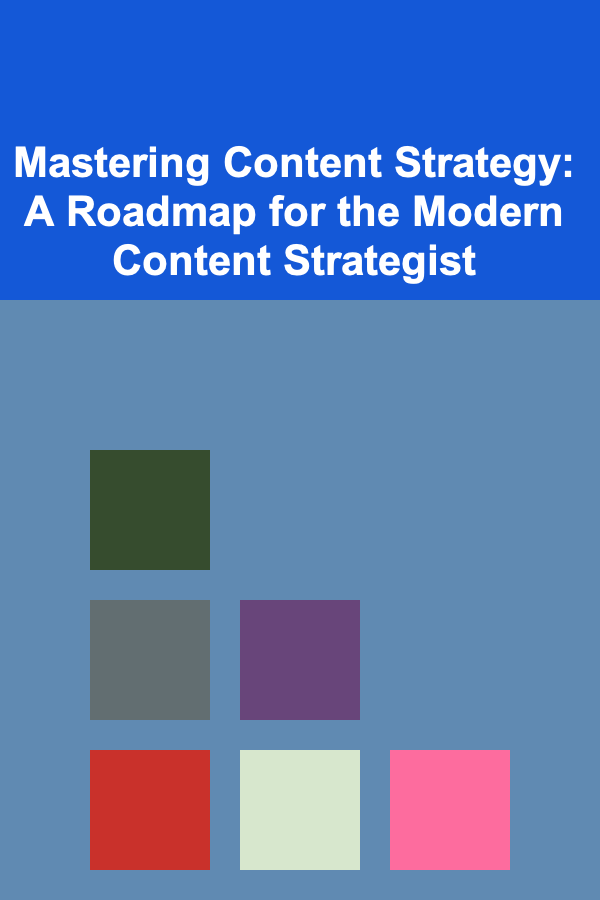
Mastering Content Strategy: A Roadmap for the Modern Content Strategist
ebook include PDF & Audio bundle (Micro Guide)
$12.99$10.99
Limited Time Offer! Order within the next:

In today's digital age, content has become one of the most powerful tools for building brands, driving traffic, and engaging audiences. However, to truly capitalize on its potential, content must be strategically planned, executed, and optimized. This is where the role of a content strategist becomes critical. A content strategist is not just a writer or a marketer; they are the architect of the brand's digital presence. Their job is to craft a comprehensive content plan that supports business goals, resonates with the audience, and remains adaptable to changing trends.
This actionable guide will walk you through the process of mastering content strategy. Whether you're new to the field or looking to refine your skills, this roadmap provides a clear path for becoming an effective content strategist in the modern world.
Understanding the Foundations of Content Strategy
Before diving into the tactical elements of content creation and distribution, it's crucial to understand the core principles of content strategy.
Defining Content Strategy
Content strategy is the process of planning, creating, distributing, and measuring content in a way that supports business objectives and engages the target audience. It requires a deep understanding of both the audience and the brand's goals to create content that resonates with the right people at the right time.
- Actionable Tip: Start by thoroughly defining your business goals, whether they are increasing brand awareness, driving conversions, or enhancing customer loyalty. Then, align your content strategy with these goals. It's important to constantly revisit these goals as the strategy evolves.
Understanding the Audience
A successful content strategy revolves around understanding who your audience is, what they care about, and how they consume content. Audience research is key to crafting content that engages and converts.
- Actionable Tip: Conduct audience research through surveys, interviews, and analytics tools like Google Analytics, social media insights, and customer feedback. Create detailed buyer personas that reflect different segments of your audience, including their challenges, preferences, and content consumption habits.
Identifying Content Types and Channels
Content can take many forms -- blogs, videos, podcasts, infographics, case studies, and more. Each type has its strengths and is suited to different stages of the customer journey. Similarly, content needs to be distributed through the right channels, whether it's your website, social media platforms, email newsletters, or third-party publications.
- Actionable Tip: Map out the content types that are most effective for your audience. For example, if you are targeting B2B professionals, whitepapers and case studies may be more valuable, while for B2C, social media videos and blog posts may generate higher engagement.
Crafting a Content Plan
A content plan is the roadmap for all your content initiatives. It includes everything from topics and themes to formats and publication schedules. A solid content plan ensures that your efforts are aligned and that you're consistently creating content that matters to your audience.
Content Calendar
A content calendar is a visual timeline that outlines what content will be published and when. It helps organize your content creation process, ensures consistency, and helps with collaboration between teams.
- Actionable Tip: Create a monthly or quarterly content calendar that outlines themes, key dates (like product launches or seasonal events), and deadlines. Tools like Google Sheets, Trello, or more specialized tools like CoSchedule or Asana can help you streamline the process.
Keyword and Topic Research
Effective content strategies are built around topics that resonate with the audience while also aligning with search engine optimization (SEO) goals. By researching keywords and understanding what people are searching for, you can ensure that your content is discoverable.
- Actionable Tip: Use tools like Google Keyword Planner, Ahrefs, and SEMrush to conduct keyword research. Focus not just on high-volume keywords, but also long-tail keywords that capture specific audience intent. Based on this, create a list of topics that align with your business goals.
Content Format and Repurposing
Different formats serve different purposes. Blogs are excellent for thought leadership and SEO, while videos work well for brand storytelling. Podcasts offer a way to engage audiences on the go, and infographics can simplify complex information.
- Actionable Tip: Choose content formats based on audience preference and the nature of the message. Don't forget to repurpose your content across different channels. For example, turn a detailed blog post into a video, infographic, and social media snippets to maximize reach.
Content Creation: Quality Over Quantity
While consistency is important, creating high-quality content that offers value to your audience should always be the top priority. In a world flooded with content, standing out requires delivering something valuable and meaningful.
Crafting Compelling Headlines
The headline is the first thing your audience sees, and it can determine whether they engage with your content. A great headline piques curiosity, promises value, and compels people to click.
- Actionable Tip: Spend time crafting attention-grabbing headlines. Use power words, numbers, and emotional triggers to make them more appealing. Tools like CoSchedule's Headline Analyzer can help you optimize your headlines for maximum impact.
Storytelling and Brand Voice
In today's digital landscape, people connect with stories, not just dry facts. Crafting content that tells a story---whether it's a customer success story or the evolution of your product---can humanize your brand and make it more relatable.
- Actionable Tip: Develop a brand voice guide that outlines your brand's tone, style, and personality. Use this guide to ensure consistency across all content, whether you're writing blog posts, social media updates, or email campaigns. Infuse your content with storytelling elements to make it more engaging.
SEO Best Practices
A well-crafted piece of content is useless if it doesn't get discovered. SEO is critical to ensuring that your content ranks well on search engines. Incorporating keywords, creating high-quality backlinks, and optimizing on-page elements like meta descriptions and image alt text all contribute to your content's discoverability.
- Actionable Tip: Implement on-page SEO best practices, including keyword placement, internal linking, and optimizing page load speed. Focus on writing content that answers the specific questions your audience is asking, which can help with ranking for featured snippets.
Content Distribution and Promotion
Creating content is only half the battle. Distributing it effectively across the right channels ensures that it reaches your target audience.
Social Media Distribution
Social media is an essential part of content distribution. It's not just about posting links to your blog posts; it's about engaging with your audience in meaningful ways. Leverage social media platforms to distribute content, start conversations, and build relationships.
- Actionable Tip: Tailor your content to fit the platform. For example, Twitter is great for sharing quick updates and engaging in real-time conversations, while Instagram is perfect for visual storytelling. Use tools like Buffer or Hootsuite to schedule posts and track performance.
Email Marketing
Email remains one of the most effective channels for content distribution. A well-crafted email newsletter can drive traffic to your website, promote new content, and keep your audience engaged.
- Actionable Tip: Segment your email list based on interests or behaviors to send more targeted, personalized content. Use email marketing platforms like Mailchimp or ConvertKit to automate and track campaigns.
Paid Promotion
While organic reach is important, paid promotion can amplify your content's visibility. Paid campaigns, such as Google Ads or Facebook ads, can be effective for promoting content that drives conversions.
- Actionable Tip: Run A/B tests on your paid campaigns to see which headlines, images, or calls-to-action generate the best results. Start with small budgets to test what works, then scale up based on performance.
Measuring Success: Analytics and Optimization
To ensure that your content strategy is effective, you must measure its impact. Content analytics allow you to track performance, identify opportunities for improvement, and optimize your approach.
Key Metrics to Track
Important metrics for content strategy include page views, time on page, bounce rate, social shares, and conversion rates. These metrics help assess whether your content is meeting its intended goals, whether it's driving engagement, or generating leads.
- Actionable Tip: Set up Google Analytics to track key metrics, and create custom reports to measure the success of your content against your business goals. Tools like Hotjar can provide heatmaps to show how visitors interact with your content.
Continuous Improvement and Iteration
Content strategy is not static. It's an ongoing process that requires constant adaptation. Based on analytics and audience feedback, you should continually refine your strategy, experimenting with new content formats, channels, and promotional tactics.
- Actionable Tip: Hold regular content reviews to assess the performance of your campaigns. Identify areas for improvement, adjust your content calendar, and continue testing different approaches.
Conclusion
Mastering content strategy requires a blend of creativity, analytical thinking, and adaptability. By focusing on the audience, aligning content with business goals, and continuously optimizing performance, you can craft a content strategy that delivers results. Remember, successful content doesn't just appear; it's built through careful planning, execution, and constant refinement. With this roadmap, you're now equipped to navigate the complexities of content strategy and create content that resonates with your audience and drives meaningful business results.
Other Products

How to Balance Your Full-Time Job with Part-Time Writing Projects
Read More
How to Get Started with Brain-Computer Interface Development
Read More
How to Install a Home Security Camera System Like a Pro
Read More
How to Use Lighting to Complement Your Furniture and Decor
Read More
The Event Host's Toolkit: Proven Techniques for Leading Flawless Events
Read More